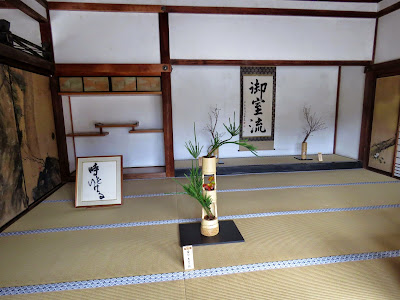
Ninja-ji Temple is also known as Omuro Gosho which had been used to serve as a summer palace for imperial family in the past. The former Abbot residence Goten was the place where its founder, Emperor Edo spent his remaining 30 years as a head priest in the Temple. Emperor Edo left home as a Buddhist monk after being on throne for 10 years. The example set by him had become a tradition and practice of reigning emperor sending a prince to the temple to serve as a head priest. The succession of temple abbot in imperial lineage lasts from year 888 until 1869.


Over many centuries, imperial members used to serve as head priest to Ninna-ji, that greatly brought up high prestige to the temple. Ninna-ji maintained a long reign as a worship venue for royal palace for centuries.



There were as many as 60 over sub-temples in the past but due to wars and fires, the number now remains only few. Most of the structures were restored in early 20th but basing on the original 9th century Heian buildings. The site is widely grown with lush pine trees that attract as much attention as foliage sight.


The several important structures inside Omuro Gosho include Main Residential Hall Shin-den, meeting and ceremonial halls Shiro-shoin and Kuro Shoin, Prayer Hall Reimei-den, Tea Houses and two gardens.


The hall of Shiro-shoin which is sometimes called as White Study Hall is an entrance to imperial living site.


Shiro-shoin was built in Heian architectural style with impressive decorative roofing.


The front view and old styled wooden door of Shiro-shoin study hall.


Next to Shinden main living area stands another meeting hall named as Kuro Shoin. It was also known as Black Study hall.


Kuro Shoin houses some Fusuma sliding doors painting, produced by ancient famous artist Iusho Domoto.



The Flower arrangements of pines setting in an imperial room are graceful.


A look out view from Kuro Shoin Study Hall.


A trees of pink camellia was found quietly blossom at a corner of the garden.


The former residence of the abbot Shinden was built to be more than a palace than a monk's living quarter.


Viewed from the veranda of Shinden, south garden is covered with sand gravel designed with simple rake lines.





The compound of Omuro Gosho was the original site of the Temple. It was built up as if a miniature palace with huge water gardens, tea ceremony houses and meeting halls within its imperial residential area.



The four major buildings in Omuro Gosho was linked up by wooden corridors which not only served as a passage way but also as an extension of each building, allowing one to stop or sit there to enjoy the fantastic sight of its garden in four seasons.





Interesting paintings appeared on wooden doors of some buildings.




Gardens that had developed with great effort in the past for the nobles to stay had turned into a model for many Japanese gardens of today.


There are two gardens at site, one is named as north garden and the other one is south garden. The elaborate North Garden is arranged with trees with water pond, rocks against the hills with a distance view of 5-storey Pagoda.



For nearly 1000 years, the head priests engaged in the temple were from imperial family. Gardens designed in imperial style with rocks, pines and ponds setting beside the surrounding of Goten building are impressive.


Heian period (794-1185) was an age of aristocracy. The refined taste was reflected in the designs of temple and gardens.




Sparse pine trees, cedar trees, maple trees, white sand, pond and bridge merged into a sight of a striking visual in fall season.


Part of the rake lined white sand is extended next to the pond of north garden.




The zig-zag wooden corridors that connected buildings to buildings continue its way right to the end of the garden. Enjoy the gardens while strolling leisurely along the wooden corridors.



The buildings at site features a sophisticated imperial architectural style.


Most of the structures contains a taste of aristocratic elegance with simplicity of Buddhism. Awesome!


A garden corner



The small praying chapel hall called Reimei-den stands facing to the north garden.


The brilliant fall foliage !


Flower arrangement is one of the cultural art of Japan. Here are some attractive outstanding pieces arranged by famous florists in kyoto.










No comments:
Post a Comment